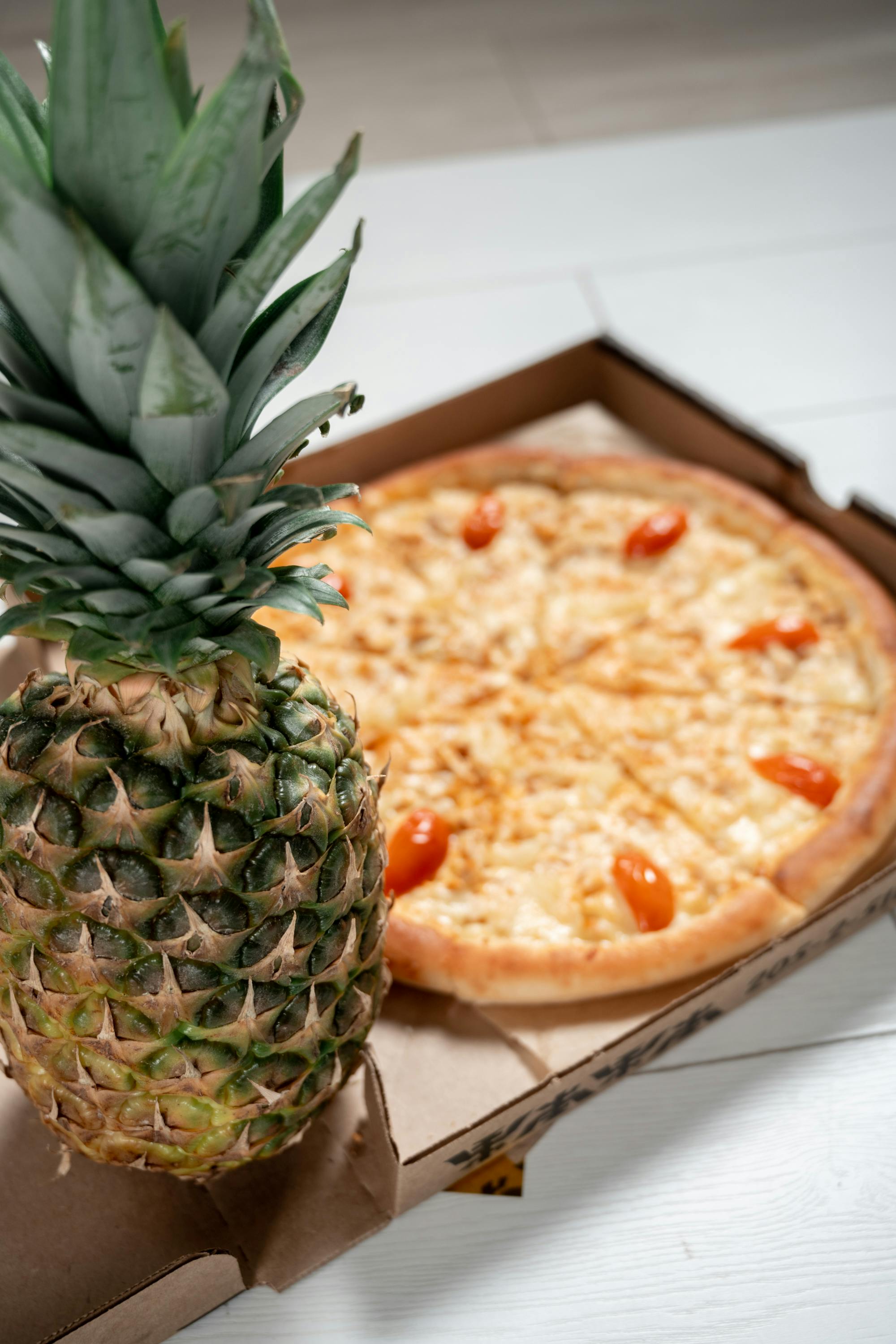Sticking Pineapple Where it Doesn’t Belong (and Why It Was Almost a Good Idea)

Let’s talk about pineapple on pizza. You either love it or you despise it with the kind of righteous anger you reserve for people who use “literally” when they mean “figuratively.” But what if, just for a moment, we stop arguing about whether this topping belongs on a pizza like it’s some sort of culinary felony, and instead, take a look at the science behind this tropical controversy? Spoiler alert: there’s more going on than just your personal preference or lack thereof for fruit mingling with cheese.
Buckle up, pizza purists and fruit-lovers alike—it's time to dive deep into the great pineapple pizza debate. Or, as some call it, "the pizza war no one asked for but everyone feels personally attacked by."
The Pineapple Debate
At the end of the day, pineapple on pizza is a matter of preference, but I’ll dig into the science of it, too.
The Issue: Sugar, Acid, and Umami War
Much like an awkward family reunion where everyone has unresolved drama, pineapple, cheese, and tomato sauce all show up to the pizza party with baggage. The acidity levels alone are like two aunts passive-aggressively one-upping each other’s homemade salsa recipes.
From a biochemical and sensory perspective, pineapple brings a high level of sugar (sucrose, fructose, glucose) and acid (mostly citric and malic acids) that clash with the umami-dominant, fat-heavy flavors of cheese and tomato sauce.
- Acidity: Pineapple’s tartness competes with the tomato sauce, which is already acidic. This can create an overly sour, cloying sensation.
- Sweetness: The high sugar content caramelizes slightly but can overwhelm the balance of the dish, making it feel more like a dessert hybrid rather than a harmonious savory dish.
- Enzymatic Disruption: Bromelain, an enzyme in fresh pineapple, breaks down proteins, including those in cheese and dough. This can create an unpleasant texture, especially if fresh pineapple isn’t pre-cooked.
Why It Still Works for Some People
Some people’s palates are just wired differently. For them, the pineapple is a delightful high note, like an unexpected saxophone solo in an otherwise straightforward rock song. Others hear that same solo and want to throw the whole band into the sea.
But despite the above problems, contrast is a core principle of great cooking—sweet and salty are a classic pairing (think salted caramel, peanut butter & jelly, or prosciutto and melon). Some people’s palates are more inclined toward sweet-savory fusion, and their brains process the pineapple’s sugar as an enhancement rather than a disruption.
Additionally, spice mitigates sweetness, which is why Hawaiian pizza improves significantly when you add pickled jalapeños or chili flakes—the capsaicin distracts the brain from sugar overload.
Now, while some foods are as simple as “I like this, I don’t like that,” pineapple on pizza is one of those foods that provokes more of an “I hate this, and I hate you too.” Why is that? For a few reasons:
1. North American Expectations vs. Global Norms
- Italian pizza culture is rooted in simplicity and ingredient synergy, emphasizing a limited palette of flavors. Pineapple is a direct affront to this philosophy.
- Many Asian and Latin American cuisines embrace sweet-savory combinations (e.g., Thai pineapple fried rice, Mexican al pastor tacos with pineapple), making them more open to the idea of fruit in savory dishes.
- The Hawaiian Pizza Paradox: The dish was invented by a Greek-Canadian (Sam Panopoulos) in Ontario in 1962—not Hawaii. It became popular because North American diners were already accustomed to sweet-savory pairings in dishes like honey-glazed ham.
2. The "Pizza Purist" vs. "Culinary Experimentalist" Divide
Pineapple pizza is often used as a litmus test for culinary conservatism. Some people believe pizza should remain a sacred, untainted relic of tradition, like the Mona Lisa or the original Star Wars trilogy. Others see it as a blank canvas for innovation—if peanut butter can go in ramen, who’s to say pineapple can’t crash the pizza party like a guy who brings his own karaoke mic to a wedding? It’s less about the ingredient itself and more about one’s philosophy of food: tradition vs. innovation.
What Was Sam Panopoulos Onto? (The Correct Culinary Principle)
Sam Panopoulos was either a culinary visionary or a chaos agent, depending on who you ask. One moment, he’s just a guy in Ontario making pizzas. The next, he’s the reason your uncle refuses to make eye contact with you at family gatherings.
If you ask me, which you totally should, my take is that while pineapple as a pizza topping is flawed, it still holds onto a fundamentally sound culinary principle: balancing sweet, acidic, and umami-rich elements in a way that enhances, rather than clashes, with the dish.
The problem isn't that fruit on pizza is bad. The problem is that pineapple, specifically, is an unbalanced execution of the idea.
The Ultimate Solution (Better Fruit-Based Pizza Pairings)
If we take the core insight of pineapple pizza (that a touch of fruit can enhance a pizza’s profile), we just need to execute it better. Here are the best solutions:
1. The Refined Classic: Pear & Gorgonzola
Pears are the polite, well-mannered cousin of the fruit world—sweet, mild, and not trying to pick a fight with your tomato sauce. Pineapple, on the other hand, kicks in the door and demands a dance-off.
Why It Works:
- Pears have a softer, more subtle sweetness than pineapple, with less acidity.
- Gorgonzola (or any blue cheese) has a pungent, umami-rich profile that counterbalances the pear’s sweetness instead of competing with it.
- Add walnuts or prosciutto for extra depth.
2. The Savory-Sweet Power Move: Figs & Goat Cheese
This one makes you seem like you’re better than other people. Big bonus: it tastes really good, too.
Why It Works:
- Figs have an earthy, honeyed sweetness that melds with cheese instead of fighting it.
- Goat cheese is tangy and creamy, which prevents the pizza from feeling too sugary.
- A drizzle of balsamic glaze completes the balance of sweet, tangy, and umami.
3. The Meat Lover’s Upgrade: Dates & Spicy Sausage
Honestly, this one’s too easy. It is hands-down a slam dunk. If you like meat on a pizza, you’ll love this one.
Why It Works:
- Dates add depth without overpowering acidity.
- Spicy sausage (or chorizo) cuts through the sweetness with heat and salt, creating a savory-sweet balance that works better than pineapple-ham.
4. The Mediterranean Masterpiece: Roasted Grapes & Ricotta
This one is probably the biggest turn-off for people, but it works as long as you treat your grapes right (I prefer to pre-cook them).
Why It Works:
- Roasted grapes bring a jammy, concentrated sweetness that melds into the cheese rather than clashing.
- Ricotta keeps things light and fresh instead of heavy and fatty like mozzarella.
- Works beautifully with a touch of fresh rosemary.
5. The Boldest Experiment: Blackberry & Hot Honey Pepperoni
This is the type of pizza that makes you feel like you’re making a bold life choice, like skydiving or cutting your own bangs. It might be genius. It might be a mistake. Either way, it’ll be memorable.
Why It Works:
- Blackberries add a dark, slightly tart sweetness that doesn’t overpower.
- Hot honey and pepperoni already have a cult following, and the blackberries enhance the contrast.
- It’s like a refined, balanced version of Hawaiian pizza with better ingredient synergy.
Conclusion (The Best Execution of the Pineapple Pizza Concept)
Pineapple pizza wasn’t a bad idea—it was just the wrong execution, like inventing roller skates but forgetting to add brakes. Now, with the right fruit, cheese, and balance, you can finally enjoy a pizza that doesn’t cause a full-blown moral crisis at dinner.
The best alternatives involve:
✔ Lower acidity fruits (figs, pears, grapes, blackberries)
✔ Cheeses that naturally enhance sweetness (gorgonzola, goat cheese, ricotta)
✔ Savory or spicy elements to ground the dish (prosciutto, sausage, chili)
So, yes, pineapple pizza was onto something. They just... did it wrong. But now, you can do it right.
 Matthew Christensen
Matthew Christensen
Weekly Newsletter Contributor since 2023
Email the author! matthew@dvo.com
